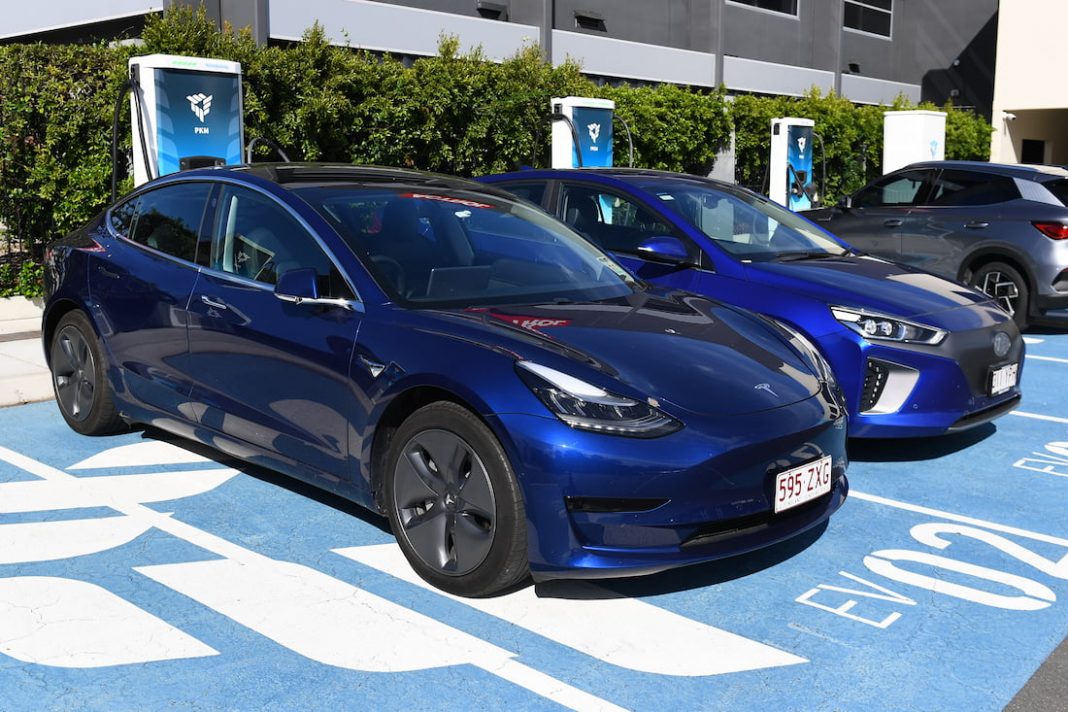Electric vehicle sales are charging ahead in Australia, outpacing predictions and expected to exceed government forecasts by a third during the next year.
But the fast pace of adoption is delivering challenges for another type of ‘charging’ as power providers and service stations rush to meet surging demand.
Australia’s big four electric car-charging providers are already ramping up investments in the field, including deals signed with shopping centres, energy firms, and hundreds of new sites locked in for upgrades.
But experts say policy reforms are needed to support the rollout and in the meantime early electric car drivers may encounter blackspots in Australia.
From a slow start, electric cars have made significant gains on petrol peers, with more than 120,000 on Australia roads, according to Electric Vehicle Council estimates.
Battery-powered vehicles accounted for more than eight per cent of new cars sold in June, up from 1.1 per cent in June 2022.
Evie Networks chief executive Chris Mills says the acceleration presented a serious challenge for charging operators, who needed to plan their builds 18 months in advance.
“(The Australian Energy Market Operator) predicted 70,000 electric cars at the end of the last financial year and we ended up with more than 100,000,” he said.
“This year AEMO is predicting about 160,000 but we think there will be about 240,000 electric cars on roads by the end of next financial year.”
Mr Mills says the company, which operates Australia’s largest charging network, had doubled the number of electric vehicle chargers built in the country for the past three years running, from 20 to 40 to 80 charging stations each year.
“This year, our plan is to build 170 additional sites and that doesn’t include our fleet work,” he said.
“I don’t believe we are incapable of building 200 sites on a steady basis every year, year on year, and I’m sure the others will be able to figure it out.”
Other providers include Engie, electric car market leader Tesla, and energy giants BP and Ampol which have pledged to install hundreds of electric vehicle charging points at petrol stations.
BP has installed 84 charging points at 42 locations over the past year, while Ampol has activated 40 charging points at 17 of its Australian outlets.
“This makes up part of our national commitment to install EV charging infrastructure at more than 100 sites with over 300 charging bays to be delivered over 2023 to 2024,” an Ampol spokesman said.
The company also signed a deal to build EV chargers at Mirvac shopping centres, while BP revealed plans to offer public charging discounts through AGL and Uber.
The commitments will add to the almost 5000 public vehicle chargers that had been installed in Australia in 2022, according to Electric Vehicle Council figures.
Council energy and infrastructure head Ross De Rango says drivers are likely to see a lot more charging options pop up at servos over the next year as energy firms are particularly well placed to ramp up rollouts.
“Deploying charging infrastructure can happen quite fast, especially if you’re talking about the kind of organisation that already owns the land,” he said.
“The thing that often holds them up is the ability to connect a new large load to the network and the processes associated with that.”
But electric vehicle drivers will face challenges while waiting for more charging facilities, including blackspots particularly in regional areas, Mr De Rango says.
“If you drive the Great Ocean Road, along the cost from Torquay to the South Australian border there are no operational public fast-chargers that will work for anything but a Tesla,” he says.
“There are big stretches of blackspot in Australia where there are no high-power charging infrastructure because it just hasn’t been built yet.”
Government funding will be needed to help providers expand into low-demand locations, he says, though investments from states including Western Australia, Queensland, South Australia and NSW was helping to close gaps.
Policy reform could also boost charging options faster, Mr Mills says, calling for governments to set tighter timelines for network connection approvals and to update electricity tariffs originally designed to cater for factories.
The reforms, he says, could also result in more high-speed car-charging facilities.
“Tariff reform is really, really important,” he said.
“We have a site in Proserpine in Far North Queensland, for example, where the energy costs are more expensive than the 65c (per kilowatt hour) we charge a driver to use the site.
“We offer that because we need highway sites and we need people to feel confident they can get that recharge.”



